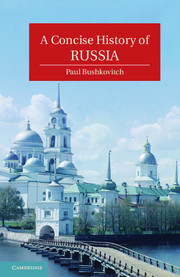Book contents
- Frontmatter
- Contents
- List of Figures
- Abbreviations
- Acknowledgments
- Prologue
- 1 Russia before Russia
- 2 Moscow, Novgorod, Lithuania, and the Mongols
- 3 The Emergence of Russia
- 4 Consolidation and Revolt
- 5 Peter the Great
- 6 Two Empresses
- 7 Catherine the Great
- 8 Russia in the Age of Revolution
- 9 The Pinnacle of Autocracy
- 10 Culture and Autocracy
- 11 The Era of the Great Reforms
- 12 From Serfdom to Nascent Capitalism
- 13 The Golden Age of Russian Culture
- 14 Russia as an Empire
- 15 Autocracy in Decline
- 16 War and Revolution
- 17 Compromise and Preparation
- 18 Revolutions in Russian Culture
- 19 Building Utopia
- 20 War
- 21 Growth, Consolidation, and Stagnation
- 22 Soviet Culture
- 23 The Cold War
- Epilogue
- Further Reading
- Index
4 - Consolidation and Revolt
Published online by Cambridge University Press: 05 June 2012
- Frontmatter
- Contents
- List of Figures
- Abbreviations
- Acknowledgments
- Prologue
- 1 Russia before Russia
- 2 Moscow, Novgorod, Lithuania, and the Mongols
- 3 The Emergence of Russia
- 4 Consolidation and Revolt
- 5 Peter the Great
- 6 Two Empresses
- 7 Catherine the Great
- 8 Russia in the Age of Revolution
- 9 The Pinnacle of Autocracy
- 10 Culture and Autocracy
- 11 The Era of the Great Reforms
- 12 From Serfdom to Nascent Capitalism
- 13 The Golden Age of Russian Culture
- 14 Russia as an Empire
- 15 Autocracy in Decline
- 16 War and Revolution
- 17 Compromise and Preparation
- 18 Revolutions in Russian Culture
- 19 Building Utopia
- 20 War
- 21 Growth, Consolidation, and Stagnation
- 22 Soviet Culture
- 23 The Cold War
- Epilogue
- Further Reading
- Index
Summary
The end of the Time of Troubles brought peace to Russia and a new dynasty of tsars, one that would remain on the throne until 1917. The decades that followed the Troubles saw the restoration of the social and political order that had existed before, so that Russia looked very much the same as it had on the day that the Assembly of the Land elected Boris Godunov tsar. Yet under the surface of restored customs and institutions, earlier trends gathered speed and new developments appeared. Serfdom provided a rigid framework that determined the life of most Russians and slowed, but did not preclude, economic changes and growth. At the other end of Russian society, at the court and among the higher clergy, shifts in religious sentiment and cultural changes were taking place that would have far-reaching effects.
Rapid population growth meant greater prosperity and also made it possible for Russia to absorb and preserve the new acquisitions in Siberia and on the southern steppes. Growing integration into the burgeoning European markets meant wealth for merchants and townsmen. The rebuilding of the government was not limited to the restoration of the old system and old institutions. The creaky apparatus of the Moscow offices of state managed more or less to maintain control over a huge area and an unruly population. Control, in the Russian context, was always a relative matter, for this was also the “rebellious” century of Russian history: with not just the Troubles but urban riots in Moscow and elsewhere, the first great Cossack and peasant revolt of the legendary Stenka Razin, and the politically crucial revolts of the musketeers at the end of the century. Each time, however, the authorities eventually restored order and, after 1613, the state did not collapse.
- Type
- Chapter
- Information
- A Concise History of Russia , pp. 59 - 78Publisher: Cambridge University PressPrint publication year: 2011

